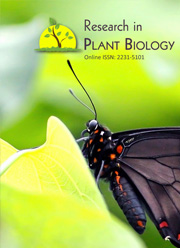Wood anatomical features of some Nigerian species of Acacia Mill and their suitability for paper making
DOI:
https://doi.org/10.25081/ripb.2021.v11.6517Keywords:
Acacia, anatomy, features, fibre, paper, pulp, taxonomy, woodAbstract
A comparative wood anatomical study of six species of the genus Acacia commonly found in Nigeria was carried out. Wood samples were collected from matured branches of plants in different locations in Mazah and Shere Hills, Jos, Plateau State, Nigeria. Transverse, tangential and radial longitudinal sections as well as wood macerates were prepared and mounted unto microscopic slides using standard anatomical methods. All the species had diffused porous wood, heterogeneous rays, aseptate fibres and predominantly solitary vessels with simple perforation plate, few pore clusters and pore multiples. Banded paratracheal axial parenchyma was common in all taxa except in A. senegal which was predominantly paratracheal without bands. Multiseriate rays were common features in all taxa except in A. nilotica which had predominantly uniseriate rays. Quantitative wood anatomical characters such as fibre length, fibre diameter, fibre lumen diameter, fibre wall thickness, vessel length, vessel diameter, ray length, ray diameter and pore diameter were of taxonomic importance in the delimitation of the studied taxa. The Runkel ratio of A. senegal (0.99µm) compared favourably with some hardwood species in the Nigerian rainforest ecosystem hence this taxon could be exploited for pulp and paper in Nigeria.
Downloads
References
Ajala, O. O. (1997). Evaluation of wood and fibre characteristics of nigerian grown Pinus carribaea. Department of Forest Resources Management, University of Ibadan, Ibadan, Nigeria.
Ajuziogu, G. C., Nzekwe, U., & Chukwuma, H. I. (2010). assessment of suitability of fibres of four nigerian fruit trees for paper–making, Bio-Research, 8(2), 679-681.
Bennie, L., Coetzee, J., Malan, E., & Woolfrey, J. R., & Ferreira, D. (2001). Oligomeric Flavanoids. Part 34: Doubly-linked Proteracacinidin analogues from Acacia caffra and Acacia galpinii. Tetrahedron, 57(4), 661-667. https://doi.org/10.1016/S0040-4020(00)01036-X
Betkas, I., Tutus, A., & Eroglu, H. (1999). A study of the suitability of Pinus brutiaten (Calabrian pine), for pulp and paper manufacture. Turkish Journal of Agriculture and Forestry, 23, 589-599.
Carlquist, S. (2001). Comparative wood Anatomy; systematics, ecological and evolutionary aspects of dicotyledon wood. (2nd ed.). Berlin: Springer.
Cronquist, A. (1981). An integrated system of classification of flowering plants (pp. 592-595). New York: Columbia University.
Evans, J. A., Gasson, P. E., & Lewis, G. P. (2006). Wood anatomy of the Mimosoideae (Leguminosae). (IAWA Journal, Supplement 5). Leiden, the Netherlands, IAWA,117.
Ezeibekwe, I. O., Okeke, S. E., Unamba, C. I. N., & Ohaeri, J. C. (2009). An investigation into the potentials of Dactyladenia bacteri; Dialum guineense; and Anthonota macrophylia for Paper Pulp Production. Report and Opinion, 1(4), 18-25.
Flath, R. A., Mon, T. R., Lorenz, G., Whitten, C. J., & Mackley, J. W. (1983). volatile components of Acacia sp. Blossoms. Journal of Agricultural and Food Chemistry, 31(6), 1167-1170. https://doi.org/10.1021/jf00120a008
Herendeen, P. S., & Miller, R. B. (2000). Utility of wood anatomical characters in species in the sub-genus Leptostemonum (BITT) DUN. Glimpses in Plant Research, 12, 73-86.
IAWA. (1989). Hardwood features list: definitions and illustration. IAWA Bulletin, 10(3), 219-332. https://doi.org/10.1163/22941932-90000247
Idu, M., & Ijeomah, J. U. (2000). Wood anatomy of some savannah fabaceae species: dimensional variation in fibre and vessel element of Daniellia oliverii (Rolfe) Hutch & Dalz. Indian Forester, 126(2), 149-153.
Kpikpi, W. M. (1992). Wood structure and paper making potentials of Ricinodendron heudelotii and Albizia zygia in relation to Gmelina arborea in Nigerian. Journal of Botany, 5, 41-50.
Krisdianto, K., & Damayanti, R. (2007). Anatomical properties and fiber dimension of prickly Acacia (Acacia nilotica L.) from Balusan National Park. Indonesian Journal of Forestry Research, 4(2), 93-103. https://doi.org/10.20886/ijfr.2007.4.2.93-103
Malan, E., & Roux, D. G. (1975). Flavonoids and tannins of Acacia Species. Phytochemistry, 14(8), 1835-1841. https://doi.org/10.1016/0031-9422(75)85306-4
Metcalfe, C. R., & Chalk, L. (1950). Anatomy of the Dicotyledons: Leaves, stem, and wood in relation to taxonomy (pp. 476-487). Oxford: Clarendon Press.
Metcalfe, C. R., & Chalk, L. (1989). Anatomy of the Dicotyledons (Vol. 2, pp. 98-116). (2nd ed.). Oxford : Clarendon Press.
Migneault, S., Koubaa, A., Erchiqui, F., Chaala, A., Englund, K., Krause, C., & Wolcott, M. (2008). Effect of fiber length on processing and properties of extruded wood-fiber/HDPE composites. Journal of Applied Polymer Science 110:1085–1092. https://doi.org/10.1002/app.28720
Mundotiya, A., Dash, R., Gupta, S., & Chandan, J. (2016). Anatomy of family mimosoideae from different geographical areas. International Research Journal of Biological Science, 5(3), 1-10.
Oluwadare, A. O., & Ashimiyu, O. S. (2007). The relationship between fibre characteristics and pulp-sheet properties of Leucaena leucocephala (Lam.) De Wit. Middle-East. Journal of Scientific Research, 2(2), 63-68.
Saini, M. L., Saini, R., Roy, S., & Kumar, A. (2008). Comparative pharmacognostical and antimicrobial studies of Acacia species (Mimosaceae). Journal of Medicinal Plants Research, 2(12), 378-386.
Secor, J. B., Conn, E. E., Dunn, J. E., & Seigler, D. S. (1976). Detection and identification of cyanogenic glucosides in six species of Acacia. Phytochemistry, 15(11), 1703-1706. https://doi.org/10.1016/S0031-9422(00)97460-0
Seigler, D. S. (2003). Phytochemistry of Acacia – sensu lato. Biochemical Systematics and Ecology, 31(8), 845-873. https://doi.org/10.1016/S0305-1978(03)00082-6
William, L. S. (1967). Kleinodendron and Xylem Anatomy of Cluytieae (Euphorbiaceae) American Journal of Botany, 54(6), 663-676. https://doi.org/10.2307/2440943
Xu, F., Zhong, X. C., Sun, R. C., & Lu, Q. (2006). Anatomy, ultra structure and lignin distribution in cell wall of Caragana korshinskii. Industrial Crops & Products, 24(2), 186-193.
Published
How to Cite
Issue
Section
Copyright (c) 2021 Seun Mercy Owolabi, Monday Daniel Odiye, Akinwumi Johnson Akinloye, Abiodun Emmanuel Ayodele

This work is licensed under a Creative Commons Attribution-NonCommercial-NoDerivatives 4.0 International License.



 .
. 